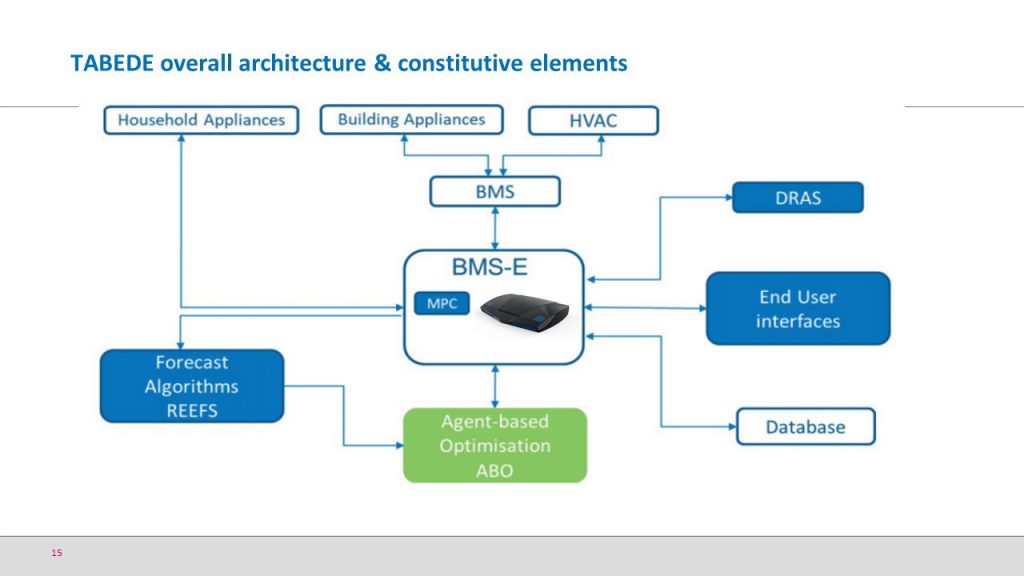ABOUT
What is Demand Response?
Demand response (DR) is a type of flexibility voluntarily provided by customers adjusting their consumption upwards or downwards in reaction to a financial incentive. It includes either manual or automatic control of their loads. DR empowers consumers (residential, commercial or industrial) to actively manage their consumption, use of distributed generation and/or storage capabilities. Unlike energy efficiency, which aims at reducing the overall energy consumption, DR is mainly about shifting consumption to a different point in time
TABEDE SOLUTION
TABEDE will pave the way to a new generation of Building Management Systems (BMS) to maximise the adoption of demand-response schemes. The proposed solution will allow the building manager to lower energy cost without affecting occupant comfort. On the other hand, the energy provider will be able to take advantage of the building flexibility to maximize the usage of renewable energy and ensure power quality.
TABEDE focuses on the development on the building side, with the aim of delivering technologies to allow all buildings to become demand-response ready without needing high investment cost. TABEDE targets existing and new building management systems (BMS), the micro-processor based networks for monitoring and control of building mechanical and electrical equipment and services such as air conditioning, ventilation and security systems.
TABEDE will act as a BMS extender to enable DR features between the grid and the BMS, as well as other appliances not connected to the existing BMS. It aims at providing, thanks to a “BMS add-on”, a bridge to the smart grid—independent from the building’s BMS brand. TABEDE will also allow the integration and the control of new elements to the BMS.
TABEDE will ensure the communication with the grid. It will provide an advanced control system, which will establish the best DR strategy to operate the connected electrical loads based on the profile received from the grid and the prediction of the renewables production (if needed and available) while respecting the occupant’s comfort and the appliances’ use constraints.
TABEDE will communicate with both the BMS and the grid. An open, semantics-based web database providing translation utilities for protocols used on demand response grids will be implemented. Whenever needed, TABEDE will communicate with the web database to get plugins or updates for the newly installed equipment.
The control strategy provided by TABEDE will be communicated to the targeted equipment via the following two options:
- indirect control of existing installations by means of set-points provided by TABEDE for the equipment that are connected to the existing BMS, such as AHU, heating, FCU, boiler and chiller,
- direct control of the new installed equipment which will be directly connected to the TABEDE bridge, such as lighting, smart plugs and EV charger.
TABEDE OVERALL ARCHITECTURE

TABEDE aims to increase flexibility of residential and tertiary buildings to interact with smart grids, provide flexibility to the power system and participate in different Demand Response schemes.
The TABEDE solution has at its centre a new BMS (BMS Extender, shortly BMS-E) that can extend existing BMS or can offer BMS services, where a BMS is not available, with the ability to collect and share data using a variety of protocols.
BMS-E communicates with other modules:
REEFS – Real-time Energy and Environmental Forecasting and Simulation receives the energy consumption data from the BMS-E and uses it to produce 24-hour, day-ahead forecasts.
ABO – Agent Based Optimizer receives the forecasts from REEFS and combines it with the DR signals and user preferences it receives from the BMS-E to create optimized load profiles.
These are then sent back to the BMS-E. The BMS-E sends control signals to the appliances and equipment to match the optimization specified by ABO.
DRAS . DR Automated Server
The purpose of the DRAS is to forward to the BMS Extender all DR event information, a DR event being either an explicit request through DR programs or an incentive through grid tariffs.
End User Interfaces
To offer the same end user interface on different terminals (tablet, smartphone, desktop computer), a web application focused on the frontend side e.g. directly running on a web browser will be developed. The end user interface shall provide a dashboard with widgets allowing to control and monitor various indicators from the health of a building to the cost saving by increasing the smart grid flexibility.
MPC – Model predictive control
Model predictive control (MPC) is applied to indoor environmental variables (e.g. temperature) control of the building. As the agent-based optimization (ABO) is designed to provide optimization considering grid incentives and all energy related devices in the building, it requires network for fetching information (e.g. historical energy consumption) for its algorithms, it will be limited or not working without network support. Therefore, MPC component will be the baseline method or optimization model for TABEDE extender. When network is disconnected, the simplified MPC installed in the TABEDE extender can do simple optimization or management of onsite thermal components.
